- Know about the origin, evolution of Silambam, traditional martial art form of Tamil Nadu and 8 categories of silambam.
Silambam is one amongst the oldest martial arts in the world. It is a martial
art which mainly based on weapons, the most widely used weapon being a stick. Silambam
has its roots in the state of Tamil Nadu, in south India.
The word Silambam holds a meaning which describes the nature of the sport. Silam is ‘mountain’ and bam is ‘bamboo’ i.e. the main weapon used in this form of martial arts.
Sillappadikkaram (one of the oldest Tamil
literature works) and many other works of Tamil Sangam period (a period when
literature flourished in Tamil) refer to the practice of silambam way back in
the 2nd century BC whereas oral folk tales traces it back even further to 7000
years.
This sport has a relevance. In earlier times our ancestors lived in jungles whee
humans and wild animals co-existed. Humans needed to know Silambam to defend
themselves from those animals that could harm them.
So in the initial stage instruments like stones were seen as a weapon or (a tool) with which they could protect themselves. But unfortunately that wasn’t much effective. That is when man picked up a stick and started using it for the purpose of self-defence. In many ways this could be considered the birth of Silambam.
From then
on various methods and techniques were discovered on how best to use a simple
stick. These techniques include a variety of unique rotations and different
methods of attacking and defending with a stick.
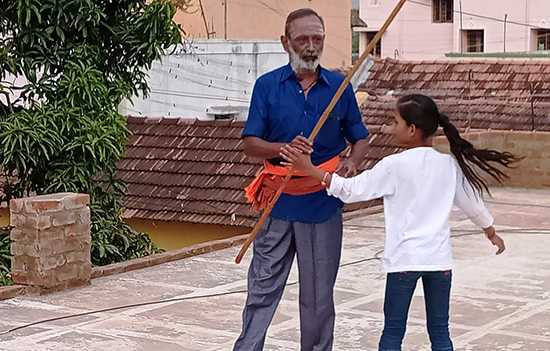 Guruji with student.
Guruji with student.Many moves were crafted after keenly observing different kinds of animals for e.g. rotation of stick is associated with the trunk of the elephant, speed is related to a horse and when attacking is connected with a tiger.
A proper structure to this art form was given by Agastya Muni (one of the
Saptarshi) at a place known today as Mukambur, which is located at the banks of
River Cauvery.
Also read About
Agastya Muni
At a point of time this martial art form was so common that it practiced in
each every city and village of Tamil Nadu. Then this art form produced many
skilled and talented warriors who also contributed in different wars.
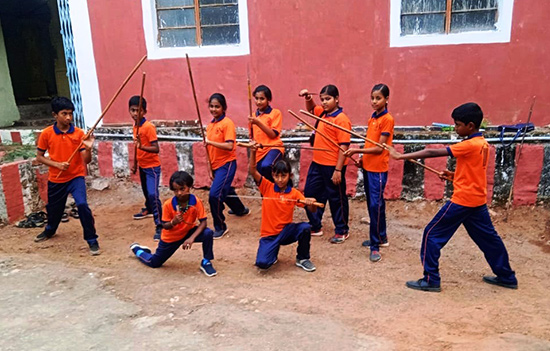 Students at Guruji Academy.
Students at Guruji Academy.Even though weapons play a major role in Silambam the foot movement is key elements to silambam. Silambam is divided into 8 categories which are –
1. Kuravanji (was initially
practiced by people who resided in hilly areas).
2. Dhulkana.
3. Kalam Patthu.
4. Madhikettan
Three and four above are majorly practiced in the
southern districts of Tamil Nadu. They make a lot of sound (noise) when
practicing this.
5. Maratiyam (consists of a lot of techniques that
were used by Chhatrapati Shivaji Maharaj).
6. Kkattaboman (practiced in Thirunalveli district
of Tamil Nadu)
7. Vel Kambu.
8. Surul Kathi/Urumi (Flexible Sword).
Under each of the above categories come many more weapons for e.g. Irattai kambu (double stick), Padai virrati (a kind of rotation done
with stick to chase away a large force), Mulkondu, Thei Pandham (fire stick) and Valum
kedayam (sword and shield).
Each and every movement or attack done in Silambam has a name for itself. These
names self-depict the movement.
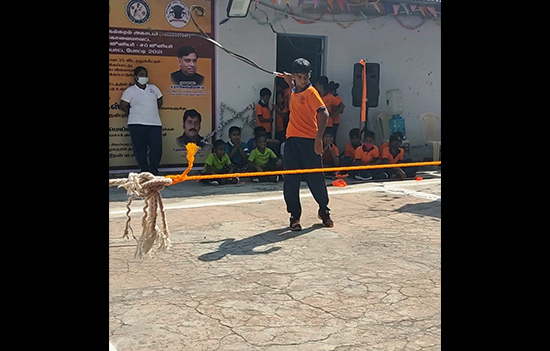 Boy doing flexible sword rotation (Urumi Vessal).
Boy doing flexible sword rotation (Urumi Vessal).In the
initial days of training the students practice hearing the command given by the
guru (in Silambam the guru is referred as the Aasan). Then they start practising seeing the gesture of the Asan. Later
on the students come to a stage where they understand the command by just
noticing eye movement and finger movements of the Aasan.
In the beginning of the British era there were a lot of people who were
practicing Silambam. And these warriors were rebelling against the British rule.
Worried that they would not be able to keep such people under their control the
British banned this art form.
Some of the Aasans (guru) were even hung to death. In order to make this art live longer the foot movements in Silambam were included in some of the traditional dance forms of Tamil Nadu. This is when silambam lost its combative nature and transformed itself into to a performing art.
It was only
after Independence that silambam got a fresh lease of life.
Besides Chennai, the Academy-Rudhransha Tamilar Veeravvilayattu Pallli has branches in Coimbatore, Thirupattur, Sivagangai, Alandurai and Perur. Their number is 91 90870 55150
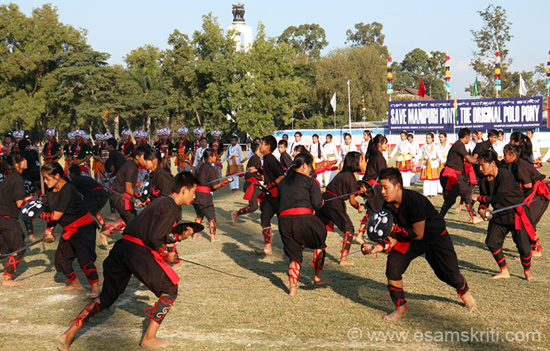 Thang ta martial mart form of Manipur.
Thang ta martial mart form of Manipur. 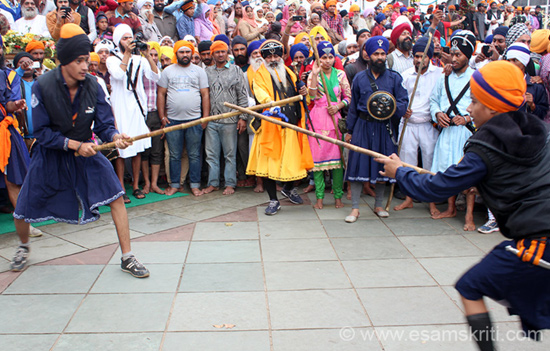 Gatka is a weapon based art form of Punjab.
Gatka is a weapon based art form of Punjab. Pictures in article, of silambam by author. Above two pictures from esamskriti collection. Big thanks to Prasanna for translating matter from Tamil to English. And gratitude to Guruji for sharing knowledge so willingly and promptly.
Also read
1. Silambam – A moving meditation
“Other weapons lie in a large heap in one corner: more staffs (this is the primary weapon of the martial art); a large sword or vaal veechu; an unusual looking weapon composed of the horn of a black buck called madavu; an intimidating looking metal whip called surul vaal; and a pair of innocuous-looking slender bamboo sticks."
2.
About
Kalaripattyu, martial art form of Kerala
3.
Why
Silambam is getting a new life
“In towns like Thanjavur, Thoothukudi, Kanyakumari, Nagercoil, Salem and Coimbatore, he says, the martial art form is still practised the traditional way.”
4.
Gatka at
Anandpur Sahib , Punjab (nihang games)
Gatka is a weapon-based art whose present form was created post 1857. “It gained popularity when the British banned the practise of Shastar Vidiya, which was punishable by death. The Punjabi word gatka refers to wooden stick used in sparring matches. The term might have originated as a diminutive of the Sanskrit word gadha or mace.” “Indian Shastar Vidya (martial art weaponry skills) is a part of the vast Vedic traditions. It is a complete science of war from hand to hand combat to battlefield strategy.”
5. Thang-ta Martial Art of Manipur